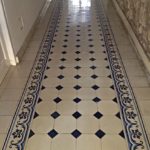Hand-made, colorful cement tile provides options for unique patterns and creative tile designs. First developed in Europe more than 150 years ago, cement creations are enjoying a resurgence in popularity throughout the U.S. and are fitting into many Madison WI projects for floors and wall tiling.
Originally, these tiles were designed to be used in a set of four where when placed correctly they create form an interlocking design. Modern applications have modified the geometric nature of installation to offer almost limitless pattern options.
What makes cement tile so appealing:
- It is extremely durable
- Hand-crafted, it provides one-of-a-kind character
- In adds color and charm indoors and outside
- It can be customized for any décor – and age-old look, art deco or contemporary
Cement Tile vs. Other Options
Popular magazines, decorating shows and home improvement websites are all promoting the wonders of tile made from cement. Are your asking: With so many ceramic and porcelain tiles to choose from why another choice? Is one better than another? How do I know? Adding to yourr confusion, these creative pieces have come to be known by other names including:
- Victorian Tiles
- Cuban Tiles
- Hydraulic Tiles
- Mission Tiles
- Encaustic Tiles
TIP FROM A PRO — Cement tile is often confused with encaustic tile because they look similar. But, encaustic tile has a base of clay not Portland cement and it is fired in a kiln. The cement versions are compressed. Even with these important differences, the names are frequently used interchangeably in the marketplace. You might even see “encaustic cement.”
The most basic difference between ceramic and cement tiles is how they are made. The creative process is what sets them apart in performance, too.
How they’re made:
- Ceramic tiles are made from colored clay – red, brown or white is most common – and either glazed or unglazed before being fired in a wood- or coal-burning kiln. Unglazed tiles usually have a matt finished appearance.
- Cement versions are formed from sand, cement, color pigment and marble powder. The elements are poured into a metal mold and backed with a dry concrete mixture. It is then compressed under 2,000 pounds of pressure.
Tile Designs Benefit from Creative Options
Its durability, insulating properties and ability to combine form and function make using cement options popular throughout the house. They can be used on walls as art work or on the floor as a unique tile rug. And, of course, they’re popular for more traditional uses in bathrooms, kitchens, laundries and entryways.
Advantages of cement tile include:
- Colorful, creative patterns – floral designs, geometric patterns, etc.
- Environmentally friendly – created with all-natural components and no fossil fuels are burned during production
- Slip-resistant – even when wet they don’t get slippery
- Customizable – your imagination can go beyond stock colors, sizes, shapes and patterns
- Robust – normally 5/8-inch thick tiles made from cement are chunkier than typical choices
TIP FROM A PRO — Because this tile is thicker than normal you will have to take into account how it will blend with molding and trim. You may have to make accommodations for these dimensional changes when going from the tile to another material – like from a tile floor to hardwood or laminate.
Tips for Using These Creative Tiles
Some areas of your home are perfect for a creative touch and these tiles can provide a rich, artistic touch. For solutions to your design visions, consider using these versatile tiles as:
- Backsplash in the kitchen
- A focal point around a fireplace
- A “statement” floor
- Special treatment on a kitchen island
If bold colors and exciting designs aren’t what you’re looking for, you can stick to more subtle tones. Cements in black, white, cream make a good base that will allow highlights to really “pop.” Highlights such as:
- Colored or textured faucets
- Decorator sinks
- Painted cabinet
- Textile accents
Select your tile carefully. Styles may not “mix and match.” Cement tile, with its unique one-of-a-kind appeal can turn basic cabinetry and fixtures from drab to exciting. Close attention to details results in a seamless, up-to-date installation.
A little goes a long way…
Hand-crafted tiles can be on the high end of the price scale, but that needn’t be a deterrent. In most cases, these unique pieces are used for visual impact and accents. So, you’re not likely to be covering a huge area – a few well-placed pieces do the trick.
Colorful tile creations and patterns offer tile designs for unique spaces. Using cement allows for spotlighting unusual areas – fireplace façade, a rug-look. Highlighting a special space can be done as “loud” or as softly as you desire. An installation of cement creations can accent a room or become the focal point.
TIP FROM A PRO — Before you complete your plans for installing cement, understand that these tiles ARE NOT pre-sealed at the factory. You will have to seal them with a good, penetrating sealer that’s designed for natural stone. Sealer is usually applied to clean tiles before grouting. Done right, water will bead up on the surface of the tile.
Look to Pros for Cement Tile Advice
For reliable tile installation and tile selection, contact Molony Tile, a source for unique, durable and elegant tile solutions.
Call or email Molony Tile, 608-268-8453 to complete your tile design and select the perfect cement tile for your Madison home.
Tile and Stone – Home Improvement Madison


